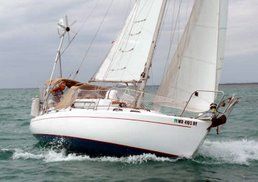fermented fish
July 14, 2008
For our last dinner at the summer cottage, we had a traditional Swedish meal of surströmming, fermented fish. Yes, fermented fish. The definition below is pretty accurate: it is fermented herring, with a very "different" taste, one that is most definitely acquired. "Strong odor" is by far and understatement. The odor was so strong that Roger had to open the pressurized can down by the water, far away from the house with a table as a shield so as not to get any of the juice on him! Lots of northern Swedes like this type of fish, although it seems that the only people that like it have been eating strömming since birth.

Roger seeks shelter behind a table when opening the surströmming, something so rank that it actually is classified as a biological weapon by the United States.
Here is a useful primer on surströmming from Wikipedia:
Surströmming ("soured (Baltic) herring") is a northern Swedish delicacy consisting of fermented Baltic herring. Surströmming is sold in cans, which when opened release a strong smell. Because of the smell, the dish is often eaten outdoors. However, opening the can under water or inside a plastic bag, somewhat lessens the smell, as well as prevents the person opening it from being soaked in brine, as the fermentation often builds up a considerable pressure inside the can.
The herring is caught in spring, when it is in prime condition and just about to spawn. The herring are fermented in barrels for one to two months, then tinned where the fermentation continues. Half a year to a year later, gases have built up sufficiently for the once cylindrical tins to bulge into a more rounded shape. These unusual containers of surströmming can be found in supermarkets all over Sweden. However, certain airlines have banned the tins on their flights, considering the pressurized containers to be potentially dangerous.[1] Species of Haloanaerobium bacteria are responsible for the in-can ripening. These bacteria produce carbon dioxide and a number of compounds that account for the unique odor: pungent propionic acid, rotten-egg hydrogen sulfide, rancid-butter butyric acid, and vinegary acetic acid.[2]
One proposed explanation of the origins of this method of preservation is that it began long ago, when brining food was quite expensive due to the cost of salt. When fermentation was used, just enough salt was required to keep the fish from rotting. The salt raises the osmotic pressure of the brine above the zone where bacteria responsible for rotting (decomposition of proteins) can prosper and prevents decomposition of fish proteins into oligopeptides and amino acids. Instead the osmotic conditions enable the Haloanaerobium bacteria to prosper and decompose the fish glycogen into organic acids, giving it the sour (acidic) properties.
Kristen smells the surströmming. Not a crowd pleaser it seems.
Kristen has a taste....
Definitely an acquired taste!


After three weeks in the cold north we migrated south to spend some time in Stockholm and especially with Hans' sister Åsa, her boyfriend Henrik and their twins Ida and Max. Ida and Max were born on May 18 when we were in Martinique, and we spent a little time with them at the summer cottage, but now we have been able to go and live with Åsa and Henrik for a few days, with the premise of helping Henrik put insulation on their new house, but probably spending more time having fika and playing with the babies!
Hans and his beautiful niece Ida, age 7 weeks.
Hans' sister Åsa's twins Max and Ida in their stroller.
Ida takes a bath... lucky Hans gets to hold her.
Kristen and Åsa hold on to the babies.
Kristen gets ready for an exciting motorcycle ride with Henrik (exciting to say the least... try going 220 km/hr (137 mph) on a windy road and see what you think)












